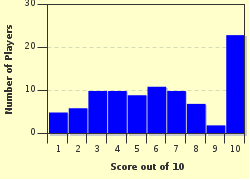Quiz Answer Key and Fun Facts
1. On April 22, 1876, who umpired the first National League baseball game in history and became the first professional baseball umpire?
2. Who serves as the liaison between the league office and the group of umpires assigned to a game?
3. Under normal situations, if an umpire works at home plate for the first game of a series, where will he work during the second game of that series?
4. Modern day umpires normally rotate field assignments with each game. Who was the last umpire to routinely serve as home plate umpire for all games he officiated?
5. Which Major League Baseball umpire died on the field after calling balls and strikes in the first inning of baseball's season opening game in 1996?
6. How many permanent umpires were on the Major League Baseball roster at the start of the 2009 season?
7. All candidates desiring to become professional umpires must first attend and complete one of two private umpiring schools authorized by and certified by Major League Baseball. In which state are both schools located?
8. Which of these baseball families has produced three generations of Major League Baseball umpires?
9. Who was the most senior active umpire and crew chief to start of the 2009 season?
10. Who were the first father-son team of umpires to work a Major League Baseball game together?
Source: Author
MaceoMack
This quiz was reviewed by FunTrivia editor
Nightmare before going online.
Any errors found in FunTrivia content are routinely corrected through our feedback system.

